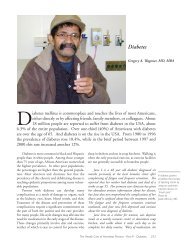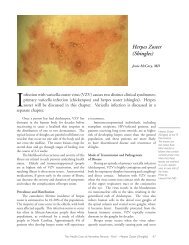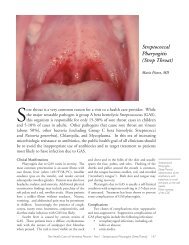Pinworm - Boston Health Care for the Homeless
Pinworm - Boston Health Care for the Homeless
Pinworm - Boston Health Care for the Homeless
You also want an ePaper? Increase the reach of your titles
YUMPU automatically turns print PDFs into web optimized ePapers that Google loves.
A third mode of transmission is “retro-infection”.<br />
This happens when <strong>the</strong> pinworms reinfect<br />
<strong>the</strong> host by hatching in <strong>the</strong> perianal region and <strong>the</strong>n<br />
migrating back into <strong>the</strong> rectum.<br />
Diagnosis<br />
Perianal and perineal itching, especially at<br />
night, and a rash coupled with insomnia are <strong>the</strong><br />
most common complaints of pinworm infection.<br />
However, many pinworm infections are entirely<br />
without symptoms.<br />
The presence of pinworms can be confirmed<br />
in one of two ways. The first is direct observation<br />
of <strong>the</strong> adult worms around <strong>the</strong> anus, perineum, or<br />
entrance to <strong>the</strong> vagina. The optimum time to see <strong>the</strong><br />
worms is 1 to 2 hours after a child has gone to bed or<br />
on awakening in <strong>the</strong> morning. A flashlight will help<br />
with <strong>the</strong> search. A second test is to observe <strong>the</strong> eggs,<br />
which are about <strong>the</strong> size of <strong>the</strong> head of a pin, under<br />
a microscope. A 2-inch strip of scotch tape can be<br />
applied to <strong>the</strong> child’s perianal area in <strong>the</strong> morning<br />
be<strong>for</strong>e <strong>the</strong> child awakens. The tape may <strong>the</strong>n be<br />
transferred to a glass slide <strong>for</strong> examination.<br />
<strong>Pinworm</strong>s can be identified about 50% of <strong>the</strong><br />
time after a single attempt at one of <strong>the</strong>se tests.<br />
These tests should be repeated over 3 to 5 consecutive<br />
mornings be<strong>for</strong>e accepting a negative result.<br />
<strong>Pinworm</strong> infection usually runs in families, and a<br />
diagnosis in one person calls <strong>for</strong> <strong>the</strong> examination of<br />
all family and household members.<br />
Treatment<br />
Most people in single family households will get<br />
rid of pinworms without treatment. Un<strong>for</strong>tunately,<br />
larger group settings such as shelters and day care<br />
centers facilitate transmission and persistent infection.<br />
Breaking <strong>the</strong> cycle of reinfection through<br />
direct and indirect contact can be very difficult.<br />
Early treatment and thorough examination of<br />
family members and close friends will increase <strong>the</strong><br />
chances of eradication. If children in different<br />
families are diagnosed with pinworms within a<br />
short time, <strong>the</strong> entire shelter or day care facility may<br />
require treatment.<br />
Pyrantel pamoate (Antiminth) kills pinworms<br />
at dosages of 11 mg/kg to a maximum dose of 1<br />
gram. Antiminth can be used in people of all<br />
ages and is not contraindicated in pregnant women.<br />
Some people develop headaches and stomach pains<br />
when taking <strong>the</strong> drug, but <strong>the</strong>se side effects are<br />
uncommon. Antiminth is currently available<br />
without a prescription. Brand names include “Pin-<br />
X” and “Reese’s <strong>Pinworm</strong> Medication”.<br />
Mebendozole (Vermox) is an antihelminthic<br />
that comes in chewable tablets of 100 mg and has<br />
few side effects. Available by prescription, this<br />
medication is not recommended <strong>for</strong> pregnant<br />
women or children under two years of age.<br />
Albendazole (Albenza) is a pinworm medication<br />
available by prescription that is usually reserved<br />
<strong>for</strong> infections that are not cleared by <strong>the</strong> o<strong>the</strong>r<br />
preparations. A single 400 mg tablet is given by<br />
mouth. Once again, this medication is not recommended<br />
<strong>for</strong> pregnant women or children under <strong>the</strong><br />
age of two.<br />
Treatment with a second dose of medication<br />
(Vermox, Antiminth, or Albenza) 14 days<br />
after <strong>the</strong> first dose has a cure rate of 90 percent. In<br />
rare circumstances 4 to 6 treatments may be necessary<br />
to get rid of <strong>the</strong> infection.<br />
Vaseline and o<strong>the</strong>r over <strong>the</strong> counter creams<br />
or ointments can help relieve <strong>the</strong> itching caused by<br />
pinworms when applied to <strong>the</strong> perianal area.<br />
Prevention and Control<br />
The control of pinworms calls <strong>for</strong> personal and<br />
environmental hygiene. Staff must be particularly<br />
sensitive to an individual’s feelings of guilt or<br />
embarrassment. <strong>Pinworm</strong>s can infect <strong>the</strong> cleanest<br />
household. When discussing hygiene, staff should<br />
emphasize <strong>the</strong> ease of transmission and frequency of<br />
reinfection. <strong>Pinworm</strong>s can spread easily to a whole<br />
family and throughout an entire family shelter<br />
unless <strong>the</strong> source is treated.<br />
During treatment <strong>for</strong> pinworms, <strong>the</strong> linens,<br />
bedclo<strong>the</strong>s, underwear, and toys of infected<br />
individuals should be washed in hot (131°F/55°C)<br />
soapy water. If washing is not possible, <strong>the</strong>n <strong>the</strong><br />
articles should be thoroughly vacuumed. Be<strong>for</strong>e<br />
cleaning, you can avoid dispersing <strong>the</strong> eggs into <strong>the</strong><br />
air by handling every article with minimal shaking.<br />
Staff and guests should damp dust, damp mop,<br />
and/or vacuum <strong>the</strong> living space of infected guests<br />
and common rooms daily <strong>for</strong> several days after<br />
treatment to reduce <strong>the</strong> number of eggs that may<br />
reside in dust.<br />
If <strong>the</strong> entire shelter needs treatment, all linens,<br />
bedclo<strong>the</strong>s, and living space should be considered<br />
infected. Guests and staff should clean all articles<br />
and spaces as described above.<br />
The following measures also help to reduce<br />
transmission:<br />
• discourage scratching in <strong>the</strong> anal area;<br />
• <strong>the</strong> use of gloves and close fitting bed<br />
clo<strong>the</strong>s can be helpful;<br />
• trim nails to minimize biting;<br />
98 The <strong>Health</strong> <strong>Care</strong> of <strong>Homeless</strong> Persons - Part I - <strong>Pinworm</strong>







